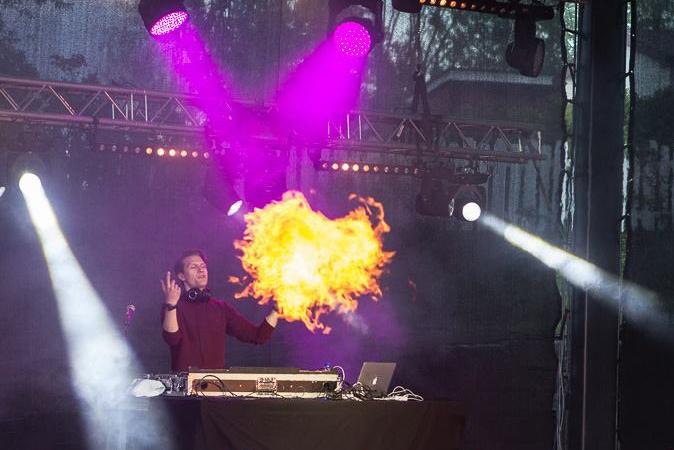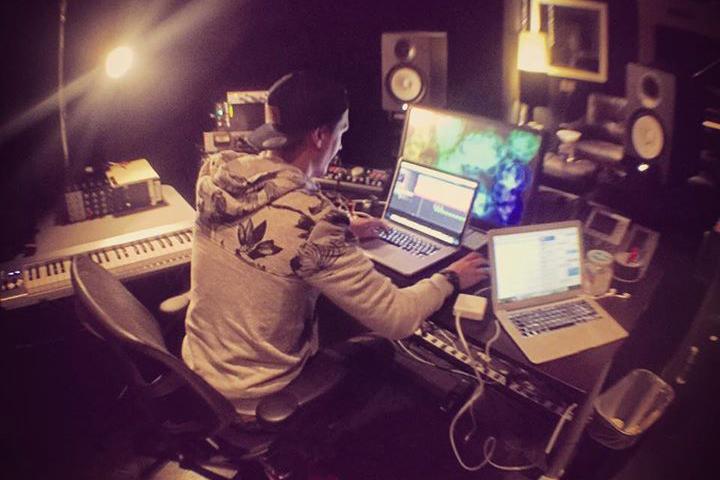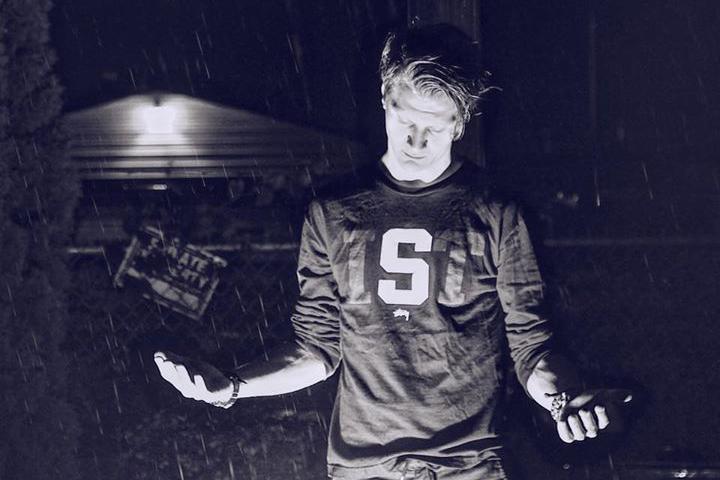
“Vocals are 70 percent of it. When you’re doing a remix, you always have to consider the vocals. That’s the main part in the song.”
Dogs days of summer getting you down? Might we suggest cuing up some tropical house music to instantly brighten your mood — namely, Matoma’s remix of The Notorious B.I.G.’s Old Thing Back, which has garnered a staggering 73 million listens on Spotify to date.
“It’s the most played and the most popular DJ song, which is quite unique,” marvels the 24-year-old Norwegian. “I wanted to keep the legacy of the greatest rapper of all time alive to the new kids, because the hip-hop they’re listening to today doesn’t have the heart.”
Old Thing Back isn’t Matoma’s only big — sorry, I mean B.I.G. — trop house remix. Just take a deep sip of his reimagining of Eminem’s Business, Jay-Z’s Roc Boys, or Imagine Dragons’ It’s Time to keep your summer party going strong. So why does Matoma have such a deep connect with listeners across the globe? His remixes are born out of respect for the source material. “When I do a remix, I always consider the original,” Matoma explains. “For example, with Old Thing Back, I didn’t fuck with the lyrics because I have too much respect for Biggie [a.k.a., The Notorious B.I.G.].

As much as he loves remixing, Matoma (born Tom Stræte Lagergren) is now working on crafting his own original material. “We may have someone ‘featuring’ on the first Matoma single, which is a new song, but I’m not sure yet,” he reveals. “I’m working really hard to keep spreading the love and making good music that’s danceable for festivals and clubs.” Digital Trends caught up with Matoma in Southern California, not long after he had his first outing on a jet ski (“So much fun — it was really cool!”), to discuss his remixing style, how he created his own sample pack, and why MP3 is “common.” Get ready to sing, relax, and feel.
Digital Trends: Do you think having been classically trained on the piano influenced how you respect melody and song structure in your remixes?
Matoma: Yeah, probably! I went to music school for three years, taking music technology and production. I respect the production part of a song; I’m not trying to overproduce it.
I’m really into sound, and sound design. The Matoma sound is when you hear that kick and you hear all the elements of the songs, like the groovy bass lines. It’s more advanced than other tropical house acts, because — and don’t misunderstand me, many of them are talented, the ones who produce from home — they don’t have the basic knowledge of sound. They don’t know how sounds are supposed to be in a big room with big speakers. They don’t know how you should have a bass line be real and big, but at the same time, let you feel the kick.
Is there a record by somebody else you consider to be a benchmark in terms of sound quality?
I would probably say, there’s another Norwegian guy called Funkin Matt. He’s more into the future house and deep house.
“I respect the production part of a song; I’m not trying to overproduce it.”
I also like Mark Knopfler. He’s a great example of a really good sound guy. I really like how he produces his albums, but it’s in a totally different genre.
Oh, that’s interesting. Mark Knopfler is one of my all-time favorite artists, ever since he was in Dire Straits. The sound quality of the records he makes and produces are always top-notch.
Listening to a good Mark Knopfler record on a high-quality speaker system that’s optimized in your living room — that would be the best way.
I totally agree. I’ve done that with his albums on vinyl, in surround sound, and via 96/24 high-res files. Do you do your mixes in the highest quality you can?
Yes! And it’s hard to do it, because when you’re doing electronic stuff, you need a lot of space. If you fill your hard drive with too many tracks, the computer shuts down. And high-resolution is much more necessary when you’re recording live than if you’re using plug-ins on your computer.
What kind of gear are you using right now?
I have a MacBook Pro, and I’m using Cubase 8 Pro. I’m also using Massive [a synthesizer plug-in], and I program my own synths.
You also work with live instruments when you can, right?
Yeah yeah yeah! I use piano, guitars, flutes. I compose a lot of music, and I record the solos live in the studio.
Are you OK with streaming music or listening to MP3s, or do you feel something is missing from those experiences?
I feel like a common person when listening to MP3s. The main problem with music today is people are using it for everything. They don’t actually sit down just to listen to music, to enjoy music. It’s not a meal.

If you go to the cinema, you go to actually see a movie, and people don’t do that with music. You go to a concert, and people get drunk or go on their phones. There are so few people in the world who actually sit down to have a good listen on a good system.
That’s what I do as much as I can. I have a name for it too — I call it appointment listening, where all I do is listen to the music, and do nothing else.
Yeah! I totally like that. My feeling about MP3s is you try and produce them as good as you can. People won’t notice the quality you’ve put in on an MP3, but you have to do it in the high-res. The percentage of most people listen to music in bad quality.
I always try to make my tracks sound as good as possible on great speakers. I produce on headphones, but I always check how my stuff sounds on shitty speakers, because I know that’s how many people are going to listen to it.
What’s your live DJing philosophy when it comes to sound quality?
“I feel like a common person when listening to MP3s.”
Live, I always play my sets in the highest WAV files. I’ll never play MP3. I see posts on the Internet where they say, “Oh, people won’t notice the MP3 in the clubs.” Yeah that’s true, because that means you think the acoustics in that club are really shitty! But if you go into a club where you know they have the high-res or the high-quality German speakers — like the really good ones they use for festivals — and you’re playing MP3 on those speakers, it will sound shitty. So like I said, I only play high-res wav files. I understand the concept of high quality. You get so much more low end when you play from that format.
Is there one song you’ve mixed that you consider to be the benchmark for quality in terms of how it sounds?
I have to say Old Thing Back is unique because of the low end, and the clarity in the drums. But if you play it from Spotify, it’s not high resolution, so… (chuckles)
When Atlantic signed Old Thing Back, they wanted to master it themselves, but I ended up mastering it. They tried, but they were so far away from my masters, so I ended up mastering it for a week before putting it up.
I’m glad you stuck to your guns on that one. Now, the a-ha track you did, The Sun Always Shines on T.V. [originally from his fellow Norwegians’ 1985 debut, Hunting High and Low] —
Did you like that one?
I did! That’s a perfect example of your remixing style. You don’t want the melody to be exactly the same, but it needs to be grounded in the original to some degree for context before you do your trop-house thing with it.
Yes, because when I do a remix, I consider the original, always.
It would really be interesting to hear what you could do with other ’80s bands like U2 or Duran Duran, and really sink your teeth into a full-on rock production, even more than what you did with Imagine Dragons’ It’s Time. Have you thought about that?
Yeah, yeah! I’ve thought about it. Maybe in the future, I’ll have the budget to do something like that. Right now, it’s too big.
One step at a time, as they say. But I’d sure love to hear you take a song like Where the Streets Have No Name and give it your tropical slant.
Yeah, that would be sick!
Have you ever thought about getting a full band onstage to see how that works out?
Maybe in the future. I’ve thought about getting drums, guitar, and bass, and me playing the piano. But right now, we don’t have that money.
How about surround sound — are you interested in 5.1?
I’m really interested in surround sound! I would probably do it with original stuff — maybe one or two songs on an album, really explicit, and with lyrics. It would be cool to just show people what I’m able to do with that.
Given the dynamic range you’d have to work with, I’d love to hear 5.1 versions of some of the remixes you’ve done as well.
I think with the Astrid S track, 2AM, you’d get blown away by the dynamics of the bass and the clarity of the vocals, because I really spent a lot of time getting that perfect. Also Try Me, the one with Jason Derulo and Jennifer Lopez, which was done in a really nice studio with really nice microphones and great preamps.
There’s also another thing with Matoma. When I went to music school, I sampled all different types of sounds — everything from doorknobs to doors getting closed, claps, and wind. In my library, I have a terabyte with only samples, done by myself with a really, really good microphone, the Neumann. And the preamp was an old one from the ’80s, really vintage.
“You know the saxophone in Old Thing Back? That was a plug-in I made myself!”
When I produce myself, I always go into this library and I have the best percussion from that sample pack. People have given me credit for the drums, because they sound so real. It is real, because I sampled it.
You know the saxophone in Old Thing Back? That was a plug-in I made myself! It was done during my last year in school. I had a guy play a real saxophone, and recorded every note six or seven times, with different velocity. The saxophone guy played it, and I recorded a pitchbend [i.e., going from one note to another].
I made an algorithm where, when I play that plug-in it on the keyboard, I can choose the sax to sound more electronic or acoustic, depending on whether the track is more electronic or more acoustic.
I love that attention to detail. And you’re right — your drum sound is so damn good. If you don’t have a really good snare sound, it can throw an entire track off.
You can buy sample packs online, but the quality is so shit. The sounds are way overcompressed, because if you go into an EDM site where you can buy plug-ins and samples, they’re just so loud and so big — and overcompressed. That isn’t nice.
Me, my biggest project was 190 tracks. Technology has moved forward, and the opportunities you have today that you didn’t have back then — I’m a really lucky guy, because I like being in an era where technology is moving so fast, and you have all these new gadgets coming out every single day. It’s really cool for a producer.
And as a producer who understands composition, song structure, melody, and lyrics, you take it into a different area than what other people can do. We may have to call you the modern-day Amadeus, or something.
Thank you for that, I really appreciate it! 2AM, for example — Astrid S, her voice is really like mystical, and I just wanted to complement her voice, and give it structure, with both live elements and electronic elements. To me, it sounds like a Viking soundtrack, if you know what I mean. That’s one of my favorite tracks. Astrid is really a talented girl, and she’s from Norway too. She’s starting to blow up internationally.
You heard her here first! You know, the way you deploy some of your effects reminds me of Pink Floyd.
Yeah, maybe! (laughs) Pink Floyd — I have so much respect for those guys back in the day, because they had to record on analog equipment, and on eight tracks. And when they had those eight tracks full, they had to bounce that to one tape, and then they had to start over again. That’s crazy, the amount of work they did! They always had really good sound and engineering.
Can I ask for a Pink Floyd Matoma remix? You could get your hands on a 23-minute track of theirs like Echoes, and then just take it right on up into the trop house stratosphere.
Yeah, I’d love to do that! I think that would probably be sick.








